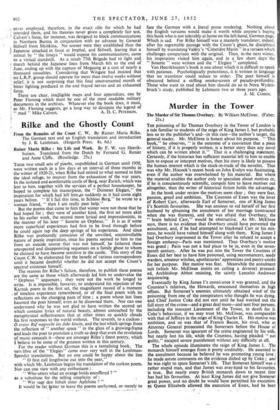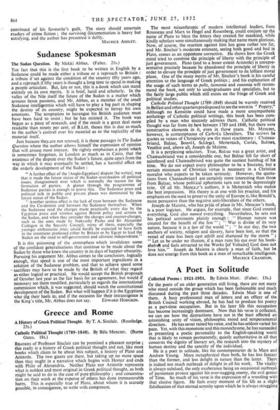Murder in the Tower
THE poisoning of Sir Thomas Overbury in the Tower of London is a tale familiar to students of the reign of King James I, but probably less so to the publisher's and—in this case—the author's target, the general reader. Mr. McElwee is honest about his purpose. " This book," he observes, " is the outcome of a conviction that a piece of history, if it is properly written, is a better story than any novel which can be written about it." That is a challenging statement. Certainly, if the historian has sufficient material left to him to enable him to expose or interpret motives, then his story is likely to possess the human interest which is the stock-in-trade of the novelist. That was why Mr. Hiscock's recent book on John Evelyn was fascinating, even if the author was overwhelmed by his material. But where the material enables the author only to speculate about motives or, if he is conscientiously scientific, compels him to leave motives out altogether, then the writer of historical fiction holds the advantage.
In the book under review the motives seem clear ; they were fear, passion, greed and ambition. The Countess of Essex was the lover of Robert Carr, afterwards Earl of Somerset, one of King James I's Scottish favourites. She was anxious to rid herself of her first husband by gbtaining the annulment of her marriage (contracted when she was thirteen), and she was afraid that Overbury, the " brain behind Carr," would be obstructive. As Mr. McElwee says, there is no evidence that Overbury could have prevented the annulment, and, if he had attempted to blackmail Can or his mis- tress, he would have ruined himself along with them. King James I had Overbury imprisoned in the Tower after he refused to accept a foreign embassy—Paris was mentioned. Thus Overbury's motive was greed ; Paris was not a bad place to be in, even in the seven- teenth century. After he was put into the Tower the Countess of Essex did her best to have him poisoned, using necromancers, seedy warders, amateur witches, apothecaries' apprentices and pastry-cooks for her purpose. Her motive was fear. Meanwhile the annulment suit (which Mr. McElwee insists on calling a divorce) proceed- ed, Archbishop Abbot resisting, the saintly Lancelot Andrewes acquiescing.
Eventually by King James I's connivance it was granted, and the Countess's relatives, the Howards, ensconced themselves in high offices. But Somerset's enemies ultimately obtained wind of the poisoning from one of the conspirators who thought he was dying, and Chief Justice Coke did not rest until he had worried out the full story of the crime—and a great deal more—and sent four persons, including the innocent Lieutenant of the Tower, to death for it. Coke's behaviour, if we may trust Mr. McElwee, was comparable with that of Jeffreys in the reign of King Charles II. His motive was ambition, and so was that of Francis Bacon, his rival, who as Attorney General prosecuted the Somersets before the House of Lords. Somerset was ignorant of the crime engineered by his wife, but nearly lost his life, while the Countess, having pleaded " not guilty," escaped severe punishment without any difficulty at all.
The whole episode illuminates the reign of King James I. The monarch himself emerges from it pretty creditably. He assented to the annulment because he believed he was promoting young love ; he made astute comments on the evidence dished up by Coke ; and he was right to spare Somerset life. That Somerset himself was a rather stupid man, and that James was over=kind to his favourites, is true. But nearly every British monarch down to recent time has had his favourites. At least King James did not give Somerset great power, and no doubt he would'haye permitted his execution, as Queen Elizabeth allowed the execution of Essex, had he been convinced of his favourite's guilt. The story should entertain ,readers of crime fiction ; the surviving aoCumentation is heavy but satisfying, and the author has presented it deftly.
MAURICE ASHLEY.



































 Previous page
Previous page